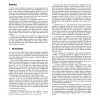Free Online Productivity Tools
i2Speak
i2Symbol
i2OCR
iTex2Img
iWeb2Print
iWeb2Shot
i2Type
iPdf2Split
iPdf2Merge
i2Bopomofo
i2Arabic
i2Style
i2Image
i2PDF
iLatex2Rtf
Sci2ools
CGA
1998
1998
Composite Lighting Simulations with Lighting Networks
A whole variety of different techniques for simulating global illumination in virtual environments have been developed over recent years. Each technique, including Radiosity, Monte-Carlo ray- or photon tracing, and directional-dependent Radiance computations, is best suited for simulating only some special case environments. None of these techniques is currently able to efficiently simulate all important lighting effects in non-trivial scenes. In this paper, we describe a new approach for efficiently combining different global illumination algorithms to yield a composite lighting simulation: Lighting Networks. Lighting Networks can exploit the advantages of each algorithm and can combine them in such a way as to simulate lighting effects that could only be computed at great costs by any single algorithm. Furthermore, this approach allows a user to configure the Lighting Network to compute only specific lighting effects that are important for a given task, while avoiding a costly s...
| Added | 21 Dec 2010 |
| Updated | 21 Dec 2010 |
| Type | Journal |
| Year | 1998 |
| Where | CGA |
| Authors | Philipp Slusallek, Marc Stamminger, Wolfgang Heidrich, Jan-Christian Popp, Hans-Peter Seidel |
Comments (0)

